I started this by reading one paper by Seth Prins and then another, the reports from the Bureau of Prisons, and an international study from Oxford – but I looked at a lot of others along the way. The data available isn’t very good. It’s hard to get excited about self-reporting questionnaires from prisoners as an accurate index of the prevalence of mental illness among the incarcerated. And the more precise information [diagnosis by interview] isn’t comprehensive. Throw in the fact that psychiatric diagnosis has radically changed in the period under question, and things get pretty mushy. But there’s something else that makes all of this infinitely more confusing, at least to me – a ringer. This is the population of incarcerated people in American Public State and Federal prisons:
And here’s the rate of incarceration over a long period of time:
The US now has far and away the largest prison population in the world no matter how it’s measured – the trend starting in the 1970s and continuing to escalate until around 2000 when it finally began to slow [see
Incarceration in the United States]. Independent of the reasons for this dramatic change, it makes it very difficult to isolate the forces acting on the Mentally Ill population.
Whereupon 1boringoldman goes off on a tangent
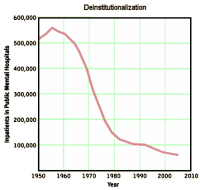 My problem is that transinstitutionalization as a concept both makes good sense and makes absolutely no sense at all. It was a huge happening, moving half a million people into the community, many of whom had chronic psychotic illnesses and a history of having been institutionalized. In my time [1970s], there was plenty of commerce among the jails, the police, the psychiatric emergency rooms, and the dwindling mental hospitals, but there was nothing that felt like it had to do with past history – even then. It felt like a today problem. The problem was with actively psychotic people with no place to stabilize them or chronic patients living on the streets with no place to go. And as brisk as the traffic between the hospitals and the jails, I don’t recall prison being in the mix. We had a model, but no way to adequately implement it. So I went back and started over. I began with this graph in transinstitutionalization? I…:
My problem is that transinstitutionalization as a concept both makes good sense and makes absolutely no sense at all. It was a huge happening, moving half a million people into the community, many of whom had chronic psychotic illnesses and a history of having been institutionalized. In my time [1970s], there was plenty of commerce among the jails, the police, the psychiatric emergency rooms, and the dwindling mental hospitals, but there was nothing that felt like it had to do with past history – even then. It felt like a today problem. The problem was with actively psychotic people with no place to stabilize them or chronic patients living on the streets with no place to go. And as brisk as the traffic between the hospitals and the jails, I don’t recall prison being in the mix. We had a model, but no way to adequately implement it. So I went back and started over. I began with this graph in transinstitutionalization? I…:
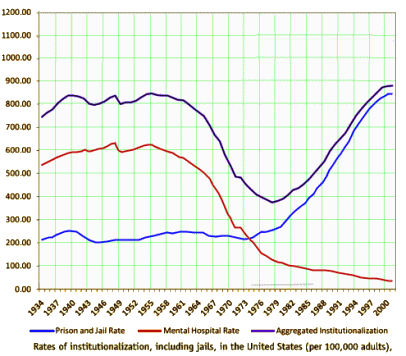
It’s all over the Internet [Google Images] – little wonder that I found it. It comes from a 2011 Law Journal article that’s not even about transinstitutionalization. It’s about violent crime eg homicide:
by Bernard E. Harcourt
The Journal of Legal Studies. 2011 40[1]:39-83.
[full text on-line]
Previous research suggests that mass incarceration in the United States may have contributed to lower rates of violent crime since the 1990s but, surprisingly, finds no evidence of an effect of imprisonment on violent crime prior to 1991. This raises what Steven Levitt has called “a real puzzle.” This study offers the solution to the puzzle: the error in all prior studies is that they focus exclusively on rates of imprisonment, rather than using a measure that combines institutionalization in both prisons and mental hospitals. Using state-level panel-data re- gressions over the 68-year period from 1934 to 2001 and controlling for economic conditions, youth population rates, criminal justice enforcement, and demographic factors, this study finds a large, robust, and statistically significant relationship between aggregated institutionalization [in mental hospitals and prisons] and homicide rates, providing strong evidence of what should now be called an institutionalization effect — rather than, more simply but inaccurately, an imprisonment or incapacitation effect.
The premise is that in the dip between deinstitutionalization and mass incarceration, there was a dramatic [and related] spike in violent crime – proxied by homicide. On the left below, I’ve lifted and added the homicide rates from Harcourt’s paper [note the scale differences] and on the right, I’ve taken the drama out of it by fitting the homicide spike to the same scale as the other parameters].
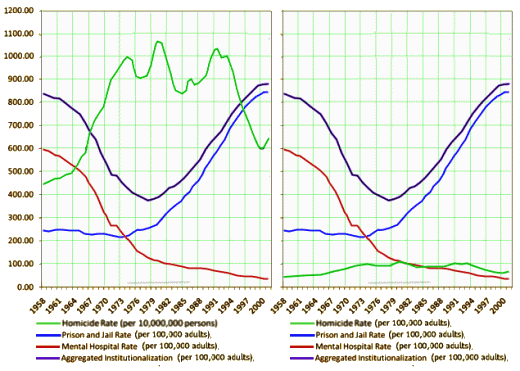
As much as I love graphs, regressions, and correlations, I don’t buy that premise for a single second, because that time-span happens to have been my adult life – and I’ve noticed that there were some other things going on: like the Civil Rights Movement, the War in Viet Nam, the Cuban Missile Crisis, the Assassinations [JFK, MLK, RFK], the Cold War, the Sixties Protests and Drug Cultures, Watts, the rise of the Drug problem in the 70s, Watergate, Reaganomics, tax cuts, spending cuts, growing national debt, personal computers, the rise of corporations, massive wealth inequity, the end of the Cold War, the medicalization of psychiatry, the businification of medicine, Monica Lewinsky? – just to mention a few among the gajillion other factors that might matter.
I have no real dog in that particular hunt, but it got me to thinking about what Seth Prins proposed about
transinstitutionalization in that first article I looked at [see
transinstitutionalization? I…], and my experienced life during the period in question:
Discussion In the debate summarized above, proponents of the transinstitutionalization hypothesis may be mistakenly drawing a causal connection between two merely correlated trends: the decline in availability of state psychiatric hospital beds and the rise in prevalence of SMI in jails and prisons. More specifically, they may [a] misinterpret deinstitutionalization as a flood of individuals who were released from state psychiatric hospitals only to be arrested and incarcerated, [b] conflate evidence that people released from psychiatric hospitals often require re-hospitalization with evidence that jails and prisons are serving that function [c] erroneously assume that people who require inpatient services are clinically and demographically similar to people with SMI who wind up in jails and prisons and [d] underestimate the effectiveness of high quality community-based treatment. The evidence against the transinstitutionalization hypothesis is compelling because [a] most people released from state psychiatric hospitals do not appear to end up incarcerated, [b] the characteristics of people with SMI in jails and prisons differ from both the characteristics of people who were deinstitutionalized and the past decades’ increasingly forensic state psychiatric hospital population, and [c] many agree that community-based treatment works for the majority of people with SMI.
… and for the same reasons I mentioned above, I agree with him. I don’t questions that our jails in many big cities are functioning like the short-term mental facilities we no longer have, and that the criminal justice system has had to take over some of the functions better handled by an intact community-based, mental health system. And I sure don’t doubt that many mental patients in prisons shouldn’t be there, and wouldn’t be there were there some reasonable system of ongoing care that functioned properly. And if transinstitutionalization were just a slang for the obvious truth – that our society has failed in its basic function of taking decent care of the less fortunate among us – I suppose this wouldn’t matter. But it’s more than that. It implies an inevitability, an excuse for our indifference to the lot of the chronically mentally ill. It’s just way too simplistic and leaves out huge swathes of related history.
[to be continued]
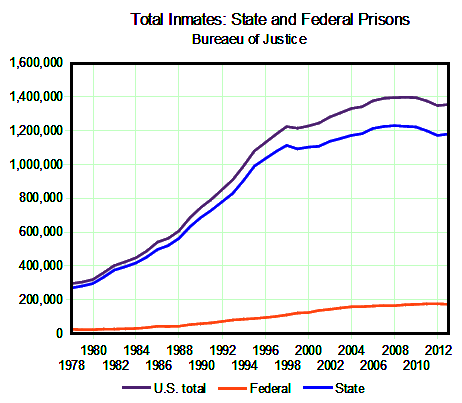
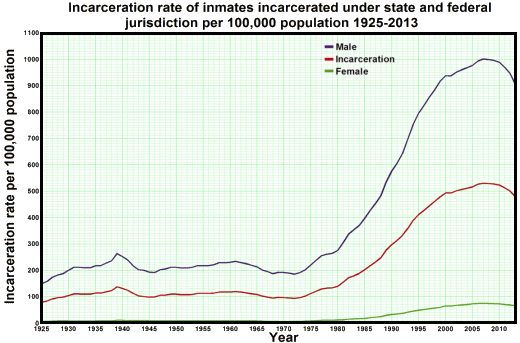
 My problem is that transinstitutionalization as a concept both makes good sense and makes absolutely no sense at all. It was a huge happening, moving half a million people into the community, many of whom had chronic psychotic illnesses and a history of having been institutionalized. In my time [1970s], there was plenty of commerce among the jails, the police, the psychiatric emergency rooms, and the dwindling mental hospitals, but there was nothing that felt like it had to do with past history – even then. It felt like a today problem. The problem was with actively psychotic people with no place to stabilize them or chronic patients living on the streets with no place to go. And as brisk as the traffic between the hospitals and the jails, I don’t recall prison being in the mix. We had a model, but no way to adequately implement it. So I went back and started over. I began with this graph in transinstitutionalization? I…:
My problem is that transinstitutionalization as a concept both makes good sense and makes absolutely no sense at all. It was a huge happening, moving half a million people into the community, many of whom had chronic psychotic illnesses and a history of having been institutionalized. In my time [1970s], there was plenty of commerce among the jails, the police, the psychiatric emergency rooms, and the dwindling mental hospitals, but there was nothing that felt like it had to do with past history – even then. It felt like a today problem. The problem was with actively psychotic people with no place to stabilize them or chronic patients living on the streets with no place to go. And as brisk as the traffic between the hospitals and the jails, I don’t recall prison being in the mix. We had a model, but no way to adequately implement it. So I went back and started over. I began with this graph in transinstitutionalization? I…:

…it implies inevitability, providing tacit excuse for the the indifference to the lot of the most unfortunate among us, whereas a functioning, high quality community based system of care provides less suffering at lower cost to society and the families that are inheriting misfortune and misery – possibly for generations. As long as MONEY is the reigning king of health care and the world, ignorance, injustice and systematic discrimination follow as the nights follow the days. Thanks for your perseverance and continuing boring to enlighten your many followers, dr Nardo. I wish you peace and happiness!
“that our society has failed in its basic function of taking decent care of the less fortunate among us ”
Amen.
Steve Lucas
It’d difficult for most people not to conflate the micro and the macro, especially within systems that rely on large scale studies for making policies. There was a time I might think that that there just wasn’t enough money to take good care of vulnerable individuals, now I suspect that it’d just not profitable enough for the Big Boys; especially now that psychiatry is lumping people under diagnoses at an alarming rate and making those diagnoses so easy to appy. There are too many people being treated with individual drug therapy to leave a lot of room for the people who need it, and need time to find what works (repeatedly). Where individual treatment is required, to many people are getting treatment based on generalizations based on generalizations, and aren’t being listened to.
My kingdom for an edit button— apply
Some questions just popped up in my mind.
1) Is it true that sociopathy is no longer in the DSM? Wouldn’t it be important to weed out sociopaths in such studies?
2) What roles do attachment problems play here and are they considered along with the usual suspects of mental illnesses?
3) What other developmental problems might be responsible for behavior that is considered to be criminal and/or symptomatic of mental illness? A person raised by two predators without healthy relationships with adults who influence them at all stages of their developments how are they can going to learn to modulate their feelings and contain understandable rage and to conform to basic social expextations?
4) When is aberrant behavior a natural physiological result of abuse and/or neglect?
There’s just not enough coffee in the world today. Please excuse my typos and mangled grammar. Brain fog.